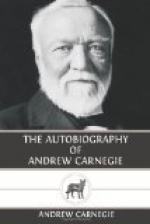My Grandfather Morrison married Miss Hodge, of Edinburgh, a lady in education, manners, and position, who died while the family was still young. At this time he was in good circumstances, a leather merchant conducting the tanning business in Dunfermline; but the peace after the Battle of Waterloo involved him in ruin, as it did thousands; so that while my Uncle Bailie, the eldest son, had been brought up in what might be termed luxury, for he had a pony to ride, the younger members of the family encountered other and harder days.
The second daughter, Margaret, was my mother, about whom I cannot trust myself to speak at length. She inherited from her mother the dignity, refinement, and air of the cultivated lady. Perhaps some day I may be able to tell the world something of this heroine, but I doubt it. I feel her to be sacred to myself and not for others to know. None could ever really know her—I alone did that. After my father’s early death she was all my own. The dedication of my first book[4] tells the story. It was: “To my favorite Heroine My Mother.”
[Footnote 4: An American Four-in-Hand in Great Britain. New York, 1888.]
[Illustration: Dunfermline Abbey]
Fortunate in my ancestors I was supremely so in my birthplace. Where one is born is very important, for different surroundings and traditions appeal to and stimulate different latent tendencies in the child. Ruskin truly observes that every bright boy in Edinburgh is influenced by the sight of the Castle. So is the child of Dunfermline, by its noble Abbey, the Westminster of Scotland, founded early in the eleventh century (1070) by Malcolm Canmore and his Queen Margaret, Scotland’s patron saint. The ruins of the great monastery and of the Palace where kings were born still stand, and there, too, is Pittencrieff Glen, embracing Queen Margaret’s shrine and the ruins of King Malcolm’s Tower, with which the old ballad of “Sir Patrick Spens” begins:
“The King sits in Dunfermline
tower,[5]
Drinking the bluid red wine.”
[Footnote 5: The Percy Reliques and The Oxford Book of Ballads give “town” instead of “tower”; but Mr. Carnegie insisted that it should be “tower.”]
The tomb of The Bruce is in the center of the Abbey, Saint Margaret’s tomb is near, and many of the “royal folk” lie sleeping close around. Fortunate, indeed, the child who first sees the light in that romantic town, which occupies high ground three miles north of the Firth of Forth, overlooking the sea, with Edinburgh in sight to the south, and to the north the peaks of the Ochils clearly in view. All is still redolent of the mighty past when Dunfermline was both nationally and religiously the capital of Scotland.




